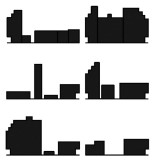Supervisors:
2014
The Gerani area, just a few minutes away from Omonoia Square in Athens, accumulates a series of problems of economic and socio-political nature, dragging it into a deep degradation and marginalization in the recent years. As a result, the local population discredits it and has been keeping a distance. Buildings become ruins and succumb to the wear and tear with exponential growth, while delinquent behaviors thrive, taking advantage of the situation, making it even worse. The eponymous street in the heart of the area stands as the most notorious of them all, as the “ghetto” of Athens, the inaccessible street.
After identifying a series of advantages and possibilities that still exist despite the downgrade, we undertake the initiative of proposing a plan to revitalize the area, focusing on Geraniou Street. This plan articulates by proposing solutions to each distinct part of the bigger problem, starting with people as a criterion and as a motive. The people that we want to administer, reside and enjoy the city and its structures.
The key aspects of the proposition come to re-shape the form of ownership and administration in economic terms, the management of the building stock, the relationship between the man-made and the natural environment and especially the program of functions and how they get distributed throughout a system of contiguous structures. We aspire that a general plan of urban revitalization that acknowledges the city as an intricate network of relations and correlations can overturn the negative status quo and trigger the application of analogous organized manipulations on a wider scale.






